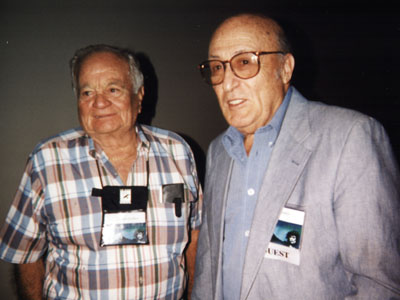
Chuck Cuidera, who worked on the classic Golden Age comic books of Blackhawk and The Blue Beetle, passed away the night of August 25. He was 86. A native of Newark, New Jersey, Chuck was an excellent athlete who somehow found his way into the world of art, winning several scholarships and eventually graduating in 1939 from the prestigious Pratt Institute — an achievement of which he was very proud and which he would mention often. He started in comics working for the notorious Victor Fox and while there, worked on the company's main super-hero, The Blue Beetle, which appeared in both comic books and strips signed "by Charles Nicholas." (Cuidera's full name was Charles Nicholas Cuidera) Others, including Jack Kirby, took over the strip, retaining the Nicholas by-line.
At times, Cuidera would claim to have created the character but the timing of its first appearance makes this assertion questionable, at best. In any case, he soon migrated to Quality Comics, run by a man named Everett Arnold, known throughout the industry as "Busy" Arnold. But most of Cuidera's early work was done in the shop of Will Eisner who was in partnership with Arnold, and it was there that Cuidera's most enduring feature, Blackhawk, was created.
Again, a bit of controversy would always surround who did what on Blackhawk. Eisner recalled involvement in writing the first story, before handing the strip over to Dick French to write. Cuidera said he created it, that Bob Powell wrote the first story and that subsequent scripts were by himself. "I never drew a script by French," Chuck insisted when I interviewed him earlier this year. "Powell wrote the first one and I wrote the rest until I went into the service."
Eisner later said of the dispute, "Whether or not Chuck Cuidera created or thought of Blackhawk to begin with is unimportant… the fact that Chuck Cuidera made Blackhawk what it was is the important thing, and therefore, he should get the credit."
What is less arguable was that Cuidera — apparently with some assistance — drew the first eleven stories that ran in Military Comics before heading off to war. He served as a commando in the 36th Infantry Division's 143rd Regiment. While stationed at Paul's Point, off the coast of Martha's Vineyard, a boat capsized during a GHQ problem and Chuck was credited with rescuing some 30 soldiers — a feat for which he was given the Soldier's Medal. He was also rewarded with the approval of a previously-filed request to transfer to the Air Force. By the time of his discharge, he had attained the rank of captain with the 8th Air Force division.
His replacement as Blackhawk artist, Reed Crandall, soon lifted the feature to new heights and became identified with it. When Cuidera returned to comics work following his discharge, Crandall remained as lead artist on Blackhawk, and Chuck occasionally inked his work and drew back-up features, while devoting much of his time to a strip called Captain Triumph. He also served for a time as Quality's Art Director, where he became known throughout the industry for his crusty, blunt management style. One of Quality's artists, John Cassone, once told me, "Chuck really chewed you out if you drew something wrong or turned work in late."
In 1956, Quality Comics sold Blackhawk to DC, and the artists went with it: Dick Dillin as penciller, Cuidera as inker. Chuck inked for other DC books over the next 14 years, including Hawkman, The Brave and the Bold and the ghost titles, but was increasingly unhappy with the business and its pay scales. At the same time, he had become interested in SCUBA diving. He successfully designed and marketed a quick-release weight belt for divers, and taught skin diving for the Y.M.C.A. all around New Jersey.
"I saw no future in comics," he explained in a recent interview. In 1970, he was mulling an offer to become involved with city planning in his home town when he got into an argument with a DC editor over corrections to his artwork…an ironic turn of events, given Cuidera's own reputation as an art director. It was at that point that Chuck Cuidera left comics and focused his energies elsewhere, soon losing all contact with the industry. Years later, he retired to Florida with his wife. Within the comic book field, he was believed to be deceased until, just a few years ago, Golden Age expert Dave Siegel tracked him down.
In 1999, Charles Nicholas Cuidera was a Guest of Honor at the Comic-Con International in San Diego and had such a good time that he came back again, this year. At the '99 con, he was reunited with his old friend and employer, Will Eisner, for a historic panel on the origins of Blackhawk.
It was a pleasure to meet and interrogate such a pivotal figure in comic history. Chuck had a hard-as-nails exterior but he was genuinely moved to discover that he had so many fans and to see so many of his old cohorts. Alas, he did not live to see the hardcover Blackhawk Archives book which DC is issuing in September, reprinting his original eleven Blackhawk stories from Military Comics, as well as several by Crandall.
Still, he was delighted to hear that his work was being preserved in that manner, and that it would be devoured by a new generation. And of course, he was well aware that the Blackhawks would long outlive their maker…